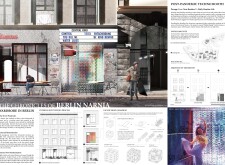5 key facts about this project
At the core of this design is the integration of natural elements into the architectural framework. The use of large expanses of glass allows for an abundance of natural light to flow through the interior spaces, creating a warm and inviting atmosphere. This choice of material also enhances visual connectivity between the indoors and the outdoors, dissolving barriers and encouraging a sense of openness. The interior layout is meticulously organized to facilitate movement and promote collaboration, with spaces designed for both individual contemplation and group engagement.
Notable architectural elements include the distinct facade, which is characterized by a series of textured surfaces that shift in response to the changing light throughout the day. This not only adds visual interest but also helps the building to blend into its surroundings. The strategic placement of windows offers views of the surrounding landscape while maintaining privacy for the building's occupants. Additionally, the roof design is functional, featuring a green roof that contributes to energy efficiency while promoting biodiversity. The use of locally sourced materials further emphasizes the project’s commitment to sustainability, reducing the environmental impact while celebrating the regional identity.
Unique design approaches are evident in the way the building engages with its context. Each aspect of the architecture has been carefully considered to enhance the community experience. Outdoor spaces are incorporated seamlessly, providing areas for social gatherings, recreational activities, and quiet reflection. This encourages not only usability but also a sense of ownership among community members, reinforcing their connection to the space. The incorporation of flexible spaces demonstrates an understanding of changing needs, ensuring that the architecture remains relevant over time.
The project's commitment to sustainability reflects a growing trend in contemporary architecture, where responsible design is paramount. The use of energy-efficient systems, including solar panels and natural ventilation techniques, ensures that the building minimizes its carbon footprint while maximizing comfort for its users. This approach to design aligns with broader architectural ideas that prioritize ecological harmony and social responsibility.
Overall, this architectural project stands as a testament to the thoughtful integration of innovative design principles and community-focused functionality. The exploration of architectural plans reveals the meticulous attention to detail and the planning that has gone into creating spaces that serve a purpose beyond mere shelter. For those interested in understanding the full scope of this project, examining the architectural sections and designs will provide deeper insights into the unique elements and thoughtful architectural ideas that define its character. This project exemplifies a meaningful approach to modern architecture, encouraging readers and stakeholders alike to engage with the vision and functionality it embodies.























